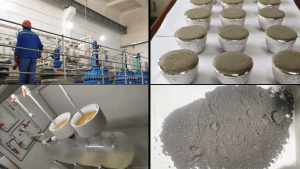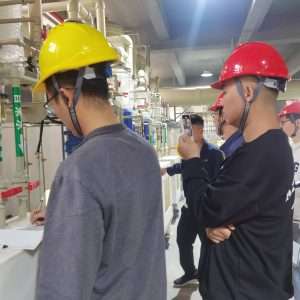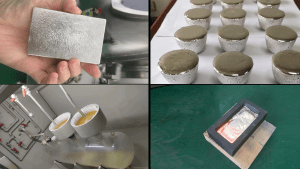Call us now:
Gold, palladium, platinum and rhodium, iridium separation methods are many, the method of replacement can be used to separate them, the first use of copper powder replacement, gold, palladium, platinum will be transferred into the replacement slag, while rhodium, iridium stay in solution, filtering will be separated. The disadvantage of the method is that the recovery rate of rhodium and iridium is not high, especially the recovery rate of rhodium is low, the reason is that the end point of replacement is difficult to grasp, solvent extraction separation technology, can be taken from the solution of gold, palladium, platinum, respectively benzene, and rhodium, iridium left to the extracted platinum residue, and then use P204 purification to remove base metal impurities, the extraction method to separate rhodium and iridium.
The production of copper powder and replacement principle.
①Production of copper powder Crystallized copper sulfate (CuSO4-5H2O) is dissolved in water, replaced with zinc powder, and then rinsed several times with water. The reaction formula is: CuSO, +Zn = ZnSO, +Cut
②The principle of substitution is as follows.
According to the order of metal activity "K, Ca, Na, Mg, Al, Mn, Zn, Cr, Fe, Co, Ni, Sn, Pd(H), Se, Bi, Cu, Hg, Ag, Pt, Au7, it is known that the potential value of copper, that is, the metal activity is stronger than that of precious metals, that is, the potential value of copper is less than the potential value of precious metals, copper in the left side of the redox potential, precious metals on the right side The copper is on the left side of the redox potential and the noble metal is on the right side, so it can displace the noble metal.
The kinetic order of replacement of noble metals is: Au>Pd>Pt>Rh>Ir.
Different metals have different redox potentials, which is an important measure of the strength of redox reactions occurring in aqueous solutions, and is a quantitative thermodynamic value for identifying redox reactions occurring in aqueous solutions.
The ionic state of the metal is transferred into solution, and the difficulty of the reaction is discriminated by using the oxidation potential. The separation of precious and base metals by selective leaching is achieved by using the difference in their oxidation potentials. The precipitation of metal ions from solution in their metallic state is achieved by applying differences in reduction potentials (e.g., extraction and refinement of metals during electrolysis).
Control system reduction potential to achieve metal selective reduction precipitation, the principle and electrolysis, electrolysis products can be used to determine the electrode potential, but also according to the different reduction potential to get the expected product. That is, easy to reduce the gold, palladium, platinum preferential selection of precipitation, and the slower reaction rate of rhodium and difficult to reduce iridium is left in solution, thus achieving gold, palladium, platinum and rhodium, iridium separation.
The larger the potential difference, the better the separation effect. But C.N. Ginzburg research proves that the platinum group metal chloride ion reduction to the metal state and the potential relationship is not consistent, but consistent with its stability constant. Due to the small difference in the rate of reduction reaction of platinum and rhodium, it is not possible to make a high recovery of platinum with complete non-precipitation of rhodium.
Only with the help of the system potential measurement and chemical analysis to understand the process of each metal replacement reaction at different potentials. Find out the high replacement rate of gold, palladium, platinum, and low replacement rate of rhodium, iridium potential range. To determine the end point of their reaction, so as to achieve the purpose of improving the recovery rate of rhodium and iridium.
The above is all about the separation of platinum, palladium and rhodium, hope it can help you, want to know more information, you can pay more attention to our website Oh ~


